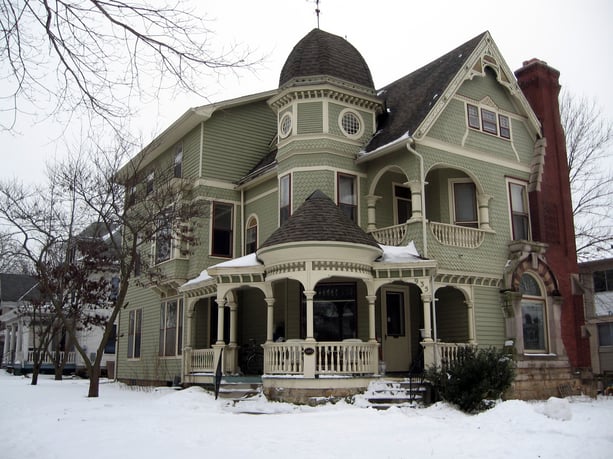
Repairing and updating historic homes in the Des Moines metro area and its surrounding towns helps preserve the unique look and feel of our communities. But older homes often need significant upgrades to be safe, habitable, and economically practical for homeowners. Frequently, historic homes need a complete roof replacement. Roofing materials that are historically correct may be extremely expensive, difficult to find, or impractical. In some cases, architectural shingles may be an option to replace your roof in a manner that preserves the historic look of your Iowa home.
What Are Architectural Shingles?
Architectural shingles are high performance, extremely durable asphalt shingles. Although they cost around 20-30% more than 3-tab asphalt shingles, they last much longer and require less maintenance and replacement. Manufacturers typically offer warranties of 30-50 years compared to warranties of only 20-30 years on standard shingles. Manufacturers offer warranties of up to 75 years for the highest quality architectural shingles.
Traditional 3-tab shingles are made of a single layer of asphalt material on top of a fiberglass or cloth mat. Architectural shingles are sturdier and heavier, consisting of multiple layers of refined asphalt and granules that are permanently laminated together. This makes them much more wind resistant as well as durable: some are able to withstand up to 120 mph winds (versus traditional-shingle wind resistance of only 60–80 mph). Architectural shingles are also resistant to fire (beneficial if lightning strikes your home) and hail damage, making them perfect for unpredictable weather all year round!
Are Architectural Shingles Appropriate for a Historic Home?
If your home is on the National Register of Historic Places or local historic certification, there may be restrictions that govern the restoration and renovations you are allowed to undertake. If you have local certification, you may have to seek approval from the State Historic Preservation Office or a local historic preservation commission or board; if you receive federal tax incentives, there are additional rules and regulations.
However, even if your home is a designated historical building, many localities’ official restoration guidelines do not have strict prohibitions or requirements to use or avoid certain materials. Although it is advisable to preserve the original material as much as possible, sometimes it’s just not possible or practical to save an old roof. It’s common to replace an entire roof to ensure a home is weatherproof and habitable.
Many historic homes originally sported wood shake roofing or wood shingles, roofing products that have lifespans of 20–40 years. If your historic home was originally roofed with a wood roofing material, it likely has undergone significant repairs and probably isn’t in great condition overall. Also, historic houses with wooden roofs often had construction called “skipped” decking under the shingles: 1- x 4-inch, 1- x 6-inch or 1- x 8-inch boards laid across the rafters, parallel with the eaves, with a gap of 1 to 3 inches between each board. The gaps allowed air in the attic to dry the shingles from the inside as well as the outside, but they made the roof more susceptible to water infiltration and provided no insulation. Poor attic insulation can lead to ice dams on the roof, damp conditions that cause mold, rot, and damage in your home, wasted energy, and high heating and cooling bills.
Why You Should Consider Substitute Roofing Materials
If your home had a wood roof originally, using authentic wooden roofing materials to replace your roof will be both costly in the short term and will ensure that you will need to do frequent repairs that can add up quickly in the future. In this situation, architectural shingles may be a great alternative. While wood roofing is extremely susceptible to fire damage, mold, rot, and wind damage, architectural shingles can give the look of traditional products with modern durability.
If your house has original clay tile, slate, or metal roofing, you may be able to repair the original roof in the parts where it is damaged. These materials last for many years and can often be repaired, which can preserve a lot of your home’s historic character and value. If you are able to retain your home’s original roof, you should consider adding additional insulation and ventilation into your attic to make your home more energy efficient and comfortable.
On the other hand, if your original roof cannot be repaired, you should investigate today’s top quality replacement materials. Several companies make substitute clay tiles from concrete that look similar to real clay tiles, and architectural shingles can convincingly replicate slate roofing at a fraction of the cost. Architectural shingles are also much lighter weight than slate, which can be a real benefit in older homes with structural issues. Roofs are one of the few places that experts and enthusiasts often concede that a substitute material is appropriate on a historic house. Contact a roofing professional to evaluate your home and recommend a roofing material that is right for you.
Hedrick Construction in Ames, Iowa, is central Iowa’s leading roofing contractor. If you live in or around Story County, and you’re considering re-roofing your historic home, contact us! We are proud to be a Platinum Preferred Contractor with Owens Corning, which makes top-of-the-line quality architectural shingles in a variety of styles and options. Contact us online for a free inspection and no-obligation estimate, or call us at (515) 597-7663.








Comments